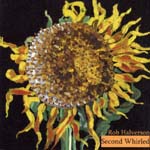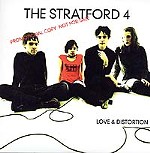La Guitarra de Callajera
By Christopher Hess, Fri., July 9, 1999
|
|
Gypsy music. The surging cadence, the sheer emotional depth resonating in every note, the unabashed drama in the dancer's every move, all evoke a music far removed from American culture. Even if this particular flamenco dance is unfamiliar to you -- even if flamenco itself is unfamiliar to you -- the pace and passion with which the music and dance is driven home in every strum and stomp screams gypsy music.
When flamenco arrived in Austin, it came in the form of a large Dutchman carrying a guitar on his back. That was 1992, prior to which Teye had spent years traveling Europe between his native Fryslan in the Netherlands, and various parts of southern Spain, learning and reveling in the sounds of flamenco. Upon hearing the distinctly Spanish sounds that issue from Teye's guitarra blanca, and considering the Latin flavor of his name, it may seem odd that this could come from a six-foot-tall Hollander.
Though most Austinites might know Teye's unique guitar work from his considerable contributions to Joe Ely's last two MCA releases, Letter to Laredo and Twistin' in the Wind, Teye's main focus is Viva Flamenco. The group, two guitaristas and two dancers, plays locally at Miguel's la Bodega every Tuesday and Malaga every Thursday, offering local audiences a unique abundance of flamenco sounds. They will be releasing their debut CD in September, hoping to bring the guitarra de callajera (the guitar of the street) to a wider audience. For Teye, coming to know this music has been the mission -- one that required a great deal of work, considering his northern roots.
"I had been looking for flamenco my whole life," he says. "It's very difficult music to get started in. The laws we usually apply to music don't apply. It's completely of a different structure. It was impossible to get started. I got stuff out of books, and out of records, but it was always like grabbing at smoke. You can't. You reach for it, and whoosh, it's gone. The more you try to grab it, the more it eludes you."
At the age of 17, Teye left his home in Fryslan and hitchhiked to London with an electric guitar on his back. He was looking to make it big in the city's pub rock scene, but the timing -- 1976, the year punk exploded into the public consciousness -- made that more difficult than anticipated. Nevertheless, Teye went through a number of bands, playing rock & roll, releasing singles, and traveling -- always traveling. While in Newcastle, Teye met a girl from Spain, and the search to reunite with her started the guitarist on this path.
"I went to visit her the next year, and she wasn't there," says Teye. "Her father told me, 'This is not the Spain you are looking for.' This was in the center, close to Madrid. You could compare it to some Russian guy coming here, being really interested in country music, and going to New York. He said, 'You know, maybe you should go south.'"
|
|
"I was about two feet taller than they, and my color was about their color mixed with five gallons of milk," he says laughing. "At that time, I had hair, and I had it up high, long and greased with the sides painted black. They sort of took me on. A lot of it was making fun of me, which at the time I totally didn't realize. But through these people, I met another group of people who were the gypsy flamencos from Cordoba, the family Muñoz."
It was here with the gypsies that Teye found the flamenco he had been searching for. In return for emergency repairs to the group's amp at a gig, he received guitar lessons. The gypsy style of playing meshed well with Teye's spirit, igniting the real fire of flamenco within him.
"[The gypsy style] is more wild and free," he explains. "It's like the black stallion in the herd. I got started really playing with them. They gave me a nickname too. At the time I was playing in a rock band called Cleopatra & the Shakin' Sphinxes. They called me El Gitano Punky, which in free translation is the rock & roll gypsy. They really took me into their middle. I was allowed to sit on stage and play along with them, probably because the addition of an extra guitar helped out a lot."
Teye spent as much time as he could -- mostly in two- to four-month stretches between working and promoting his lingering rock & roll projects -- living in Spain and learning flamenco guitar. The rich cultural history of flamenco requires the investment of much time and patience before any sort of understanding can be reached.
The origins of flamenco music, though largely guessed at since its progenitors were not literate, are attributed largely to gypsy communities centering around southern Spain. It was formed as a fusion of the Andalusian region's popular folk music and the music gypsies had been making for centuries. Public awareness of the music developed to a large extent through cantas, vocal flamenco pieces, in the region's cafes during the late 19th century. It was during this period that guitar accompaniment became an integral part of flamenco.
Shortly after the music was "discovered" on this side of the Atlantic during the Fifties, the guitar was taken from an accompanying role to a virtuostic art form in itself, a transition pioneered by the great Paco de Lucia. Though new, would-be fans of flamenco look to the more recent phenomenon of the Gipsy Kings as the breaking point for the genre, Teye affirms what is true of many forms of music that find their way into mainstream consciousness.
"People who like the Gipsy Kings, they don't want to go out and learn to play flamenco or to flamenco dance," says Teye. "Paco de Lucia teamed up with John McLaughlin and Al DiMeola, and that's where most people recognize him from. Paco de Lucia is much better heard on his own records, but sometimes you have to dilute something to take it to the masses. That's what Paco de Lucia did.
"You go back even 10 years, and people wouldn't touch it because it was music of the street, of the gypsies. You know, 'Good lord, they come to steal your stuff.' But now people are starting to get hip to the music."
The construction of a flamenco guitar is itself responsible for the sound and style of playing that embody the music.
"Flamenco guitar is like a hot rod version of a guitar," he explains. "It reacts immediately and the sound is immediately gone. You don't have the singing quality that is so characteristic of classical music or other acoustic music. If you play a chord on a well-built acoustic guitar, it will be there -- big lows and sparkling highs. Flamenco guitar, no. It's a cheap thing. It has no bottom and no top -- all it has is a mid-rangy sound to it. That's exactly what's so attractive, because if you play it right, it stings and it sings, just according to what you want. It's direct. You play on it and it's immediately there, then it's gone. That way you have room for a new note so you can be in rhythm with the dancers."
The dancers, Pepa Martínez and Teye's wife, Belén Oliva, are as much the focus of Viva Flamenco as is Teye's guitar, and they likewise acknowledge their own performance in the context of flamenco's larger purpose.
|
|
Oliva, who only two and a half years removed from her native Seville still has as strong and beautiful accent, adds, "What she says is true, but the only place you can get your inspiration for the dance is from the reason the dance was created. That together with the guitar; it's also what the gypsies made that dance for. It is passionate, or it is angry -- what they made it for is what it is about."
The sound of flamenco is like nothing else. It is fleeting, the notes dancing away as soon as they are made, each string in every strum of one melody after another receding immediately to make room for the next.
"Flamenco is all about rhythm," offers Jaime Bustillos, Viva Flamenco's second guitarist. "Nothing else matters -- not melody or anything like that. It's pretty crazy. You're really free, you can play anything that you want. It's not easy to define why it's that way. It's kind of like being."










